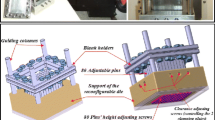Abstract
Multi-point forming is a novel flexible process that is economically suitable for both rapid prototyping and batch production of sheet metal parts. This technique is established based on altering rigid dies by matrices of adjustable punch elements. In this paper, the basic principle of this technique is implemented on deep drawing process. A reconfigurable die was constructed to investigate the multi-point deep drawing process. AA 2024-O Aluminum alloy was designated as test material. The formed specimens were evaluated in terms of dimpling defect, rupture, thickness distribution and dimensional accuracy. The onset of rupture was predicted by integrating the forming limit diagram of employed material with finite element Code. The predicted results were in a reasonable agreement with the experimental tests. It was found that for complete elimination of dimpling defect and acquiring maximum drawing depth, the proper allocation of elastic layer parameters such as thickness and hardness was crucial. The conducted investigations indicated that, in general, dimensional accuracy of formed parts was acceptable. However, for areas with sharp changes in geometry such as corners and side walls, deviation from desired geometry was evident. This phenomenon was remarkably dominant for manufactured parts utilizing softer elastic layer.

















Similar content being viewed by others
References
Vihtonen L, Puzik A, Katajarinne T (2008) Comparing two robot assisted incremental forming methods: incremental forming by pressing and incremental hammering. Int J Mater Form 1(1):1207–1210
Scherer D, Yang Z, Hoffmann H (2010) Driving–a flexible manufacturing method for individualized sheet metal products. Int J Mater Form 3(1):955–958
Arfa H, Bahloul R, BelHadjSalah H (2013) Finite element modelling and experimental investigation of single point incremental forming process of aluminum sheets: influence of process parameters on punch force monitoring and on mechanical and geometrical quality of parts. Int J Mater Form 6(4):483–510
Voswinckel H, Bambach M, Hirt G (2014) Improving geometrical accuracy for flanging by incremental sheet metal forming. Int J Material Form 1–9
Li M, Liu Y, Su S, Li G (1999) Multi-point forming: a flexible manufacturing method for a 3-d surface sheet. J Mater Process Technol 87(1):277–280
Li M-Z, Cai Z-Y, Sui Z, Yan Q (2002) Multi-point forming technology for sheet metal. J Mater Process Technol 129(1):333–338
Chen J-J, Li M-Z, Liu W, Wang C-T (2005) Sectional multipoint forming technology for large-size sheet metal. Int J Adv Manuf Technol 25(9–10):935–939
Li M-Z, Cai Z-Y, Liu C-G (2007) Flexible manufacturing of sheet metal parts based on digitized-die. Robot Comput Integr Manuf 23(1):107–115
Chen J-J, Liu W, Li M-Z, Wang C-T (2006) Digital manufacture of titanium prosthesis for cranioplasty. Int J Adv Manuf Technol 27(11–12):1148–1152
Zhang Q, Dean T, Wang Z (2006) Numerical simulation of deformation in multi-point sandwich forming. Int J Mach Tools Manuf 46(7):699–707
Zhang Q, Wang Z, Dean T (2008) The mechanics of multi-point sandwich forming. Int J Mach Tools Manuf 48(12):1495–1503
Yaşar M, Korkmaz Z, Gavas M (2007) Forming sheet metals by means of multi-point deep drawing method. Mater Des 28(10):2647–2653
Paunoiu V, Cekan P, Gavan E, Nicoara D (2008) Numerical simulations in reconfigurable multipoint forming. Int J Mater Form 1(1):181–184
Yan A, Klappka I (2008) Springback in stretch forming process of aeronautic panel production by finite element simulation. Int J Mater Form 1(1):201–204
Cai Z-Y, Wang S-H, Xu X-D, Li M-Z (2009) Numerical simulation for the multi-point stretch forming process of sheet metal. J Mater Process Technol 209(1):396–407
Liu Q, Lu C, Fu W, Tieu K, Li M, Gong X (2012) Optimization of cushion conditions in micro multi-point sheet forming. J Mater Process Technol 212(3):672–677
Sala G (2001) A numerical and experimental approach to optimise sheet stamping technologies: part II—aluminium alloys rubber-forming. Mater Des 22(4):299–315
Barlat F, Lian K (1989) Plastic behavior and stretchability of sheet metals. Part I: a yield function for orthotropic sheets under plane stress conditions. Int J Plast 5(1):51–66
Ozturk F, Lee D (2004) Analysis of forming limits using ductile fracture criteria. J Mater Process Technol 147(3):397–404
Zhang Q, Wang Z, Dean T (2007) Multi-point sandwich forming of a spherical sector with tool-shape compensation. J Mater Process Technol 194(1):74–80
Davoodi B, Zareh-Desari B (2014) Assessment of forming parameters influencing spring-back in multi-point forming process: a comprehensive experimental and numerical study. Mater Des 59:103–114
Ren L, Zhang S, Palumbo G, Sorgente D, Tricarico L (2009) Numerical simulation on warm deep drawing of magnesium alloy AZ31 sheets. Mater Sci Eng A 499(1):40–44
Essa K, Hartley P (2011) An assessment of various process strategies for improving precision in single point incremental forming. Int J Mater Form 4(4):401–412
Ambrogio G, Filice L (2012) On the use of Back-drawing Incremental Forming (BIF) to improve geometrical accuracy in sheet metal parts. Int J Mater Form 5(4):269–274
Author information
Authors and Affiliations
Corresponding author
Rights and permissions
About this article
Cite this article
Zareh-Desari, B., Davoodi, B. & Vedaei-Sabegh, A. Investigation of deep drawing concept of multi-point forming process in terms of prevalent defects. Int J Mater Form 10, 193–203 (2017). https://doi.org/10.1007/s12289-015-1268-1
Received:
Accepted:
Published:
Issue Date:
DOI: https://doi.org/10.1007/s12289-015-1268-1




